Diabetes and Related Health Issues
VerifiedAdded on 2020/05/11
|20
|6046
|180
AI Summary
This assignment requires a summary of various research papers related to diabetes. The papers cover topics such as peripheral arterial disease, neurogenic orthostatic hypotension, the effects of glucagon on hypoglycemia in type 1 diabetes, U300 insulin glargine for diabetes management, global statistics on ischemic heart disease, treatment options for diabetic neuropathy, cervical spine clearance protocols in trauma patients, pain mechanisms in diabetic neuropathy, fall risk in older adults with type 2 diabetes, and a pharmacodynamics model for glucose-insulin-glucagon interactions. The summary should provide a concise overview of the findings and implications of each paper.
Contribute Materials
Your contribution can guide someone’s learning journey. Share your
documents today.
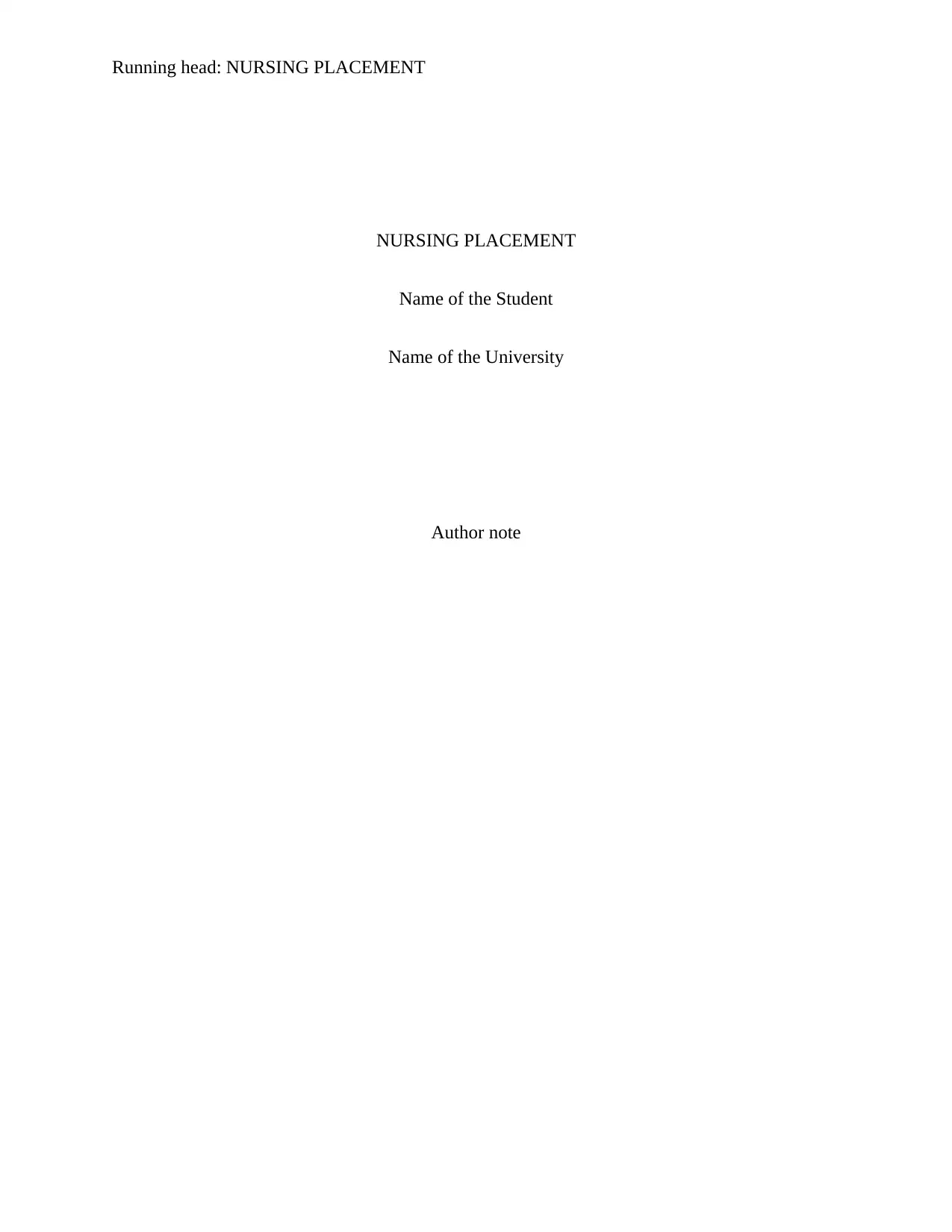
Running head: NURSING PLACEMENT
NURSING PLACEMENT
Name of the Student
Name of the University
Author note
NURSING PLACEMENT
Name of the Student
Name of the University
Author note
Secure Best Marks with AI Grader
Need help grading? Try our AI Grader for instant feedback on your assignments.
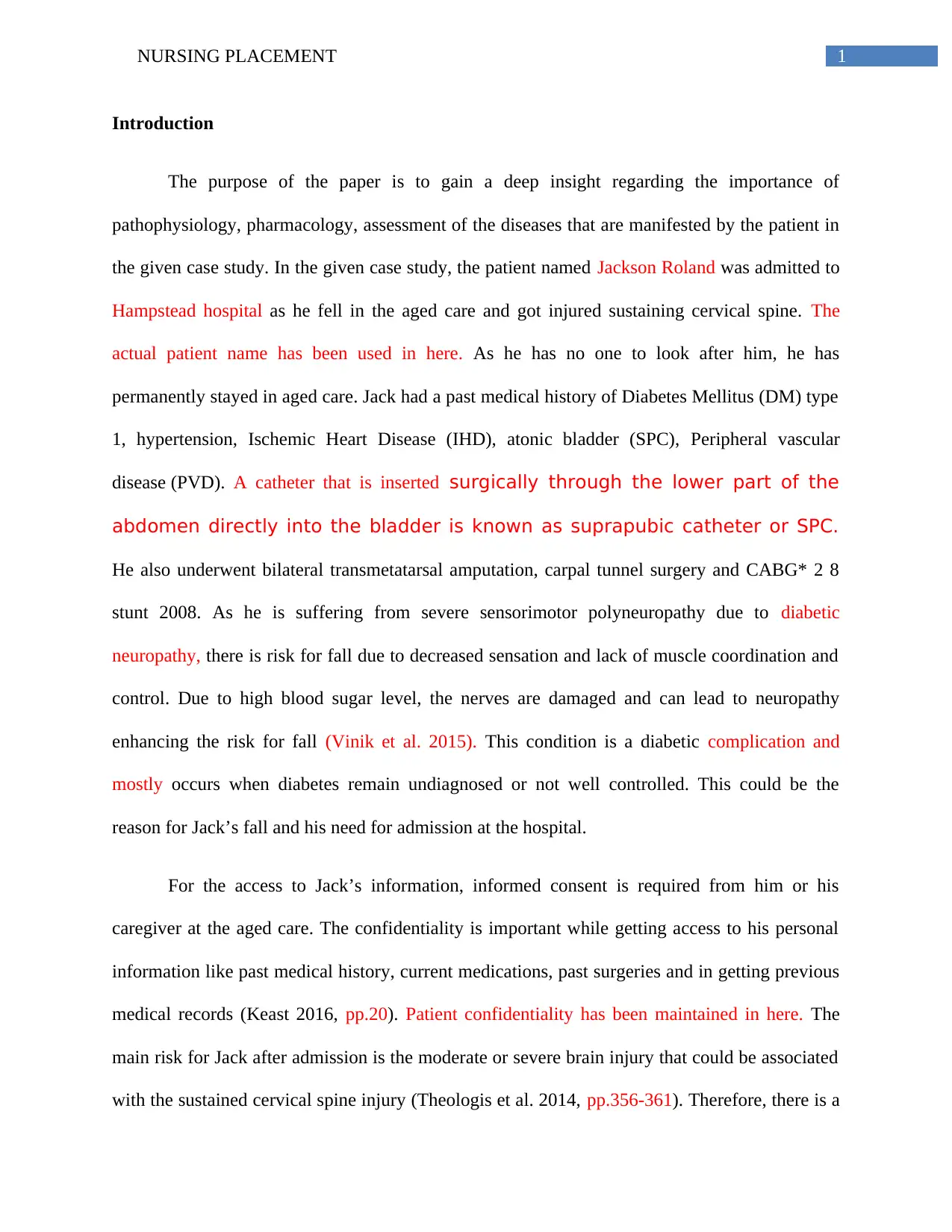
1NURSING PLACEMENT
Introduction
The purpose of the paper is to gain a deep insight regarding the importance of
pathophysiology, pharmacology, assessment of the diseases that are manifested by the patient in
the given case study. In the given case study, the patient named Jackson Roland was admitted to
Hampstead hospital as he fell in the aged care and got injured sustaining cervical spine. The
actual patient name has been used in here. As he has no one to look after him, he has
permanently stayed in aged care. Jack had a past medical history of Diabetes Mellitus (DM) type
1, hypertension, Ischemic Heart Disease (IHD), atonic bladder (SPC), Peripheral vascular
disease (PVD). A catheter that is inserted surgically through the lower part of the
abdomen directly into the bladder is known as suprapubic catheter or SPC.
He also underwent bilateral transmetatarsal amputation, carpal tunnel surgery and CABG* 2 8
stunt 2008. As he is suffering from severe sensorimotor polyneuropathy due to diabetic
neuropathy, there is risk for fall due to decreased sensation and lack of muscle coordination and
control. Due to high blood sugar level, the nerves are damaged and can lead to neuropathy
enhancing the risk for fall (Vinik et al. 2015). This condition is a diabetic complication and
mostly occurs when diabetes remain undiagnosed or not well controlled. This could be the
reason for Jack’s fall and his need for admission at the hospital.
For the access to Jack’s information, informed consent is required from him or his
caregiver at the aged care. The confidentiality is important while getting access to his personal
information like past medical history, current medications, past surgeries and in getting previous
medical records (Keast 2016, pp.20). Patient confidentiality has been maintained in here. The
main risk for Jack after admission is the moderate or severe brain injury that could be associated
with the sustained cervical spine injury (Theologis et al. 2014, pp.356-361). Therefore, there is a
Introduction
The purpose of the paper is to gain a deep insight regarding the importance of
pathophysiology, pharmacology, assessment of the diseases that are manifested by the patient in
the given case study. In the given case study, the patient named Jackson Roland was admitted to
Hampstead hospital as he fell in the aged care and got injured sustaining cervical spine. The
actual patient name has been used in here. As he has no one to look after him, he has
permanently stayed in aged care. Jack had a past medical history of Diabetes Mellitus (DM) type
1, hypertension, Ischemic Heart Disease (IHD), atonic bladder (SPC), Peripheral vascular
disease (PVD). A catheter that is inserted surgically through the lower part of the
abdomen directly into the bladder is known as suprapubic catheter or SPC.
He also underwent bilateral transmetatarsal amputation, carpal tunnel surgery and CABG* 2 8
stunt 2008. As he is suffering from severe sensorimotor polyneuropathy due to diabetic
neuropathy, there is risk for fall due to decreased sensation and lack of muscle coordination and
control. Due to high blood sugar level, the nerves are damaged and can lead to neuropathy
enhancing the risk for fall (Vinik et al. 2015). This condition is a diabetic complication and
mostly occurs when diabetes remain undiagnosed or not well controlled. This could be the
reason for Jack’s fall and his need for admission at the hospital.
For the access to Jack’s information, informed consent is required from him or his
caregiver at the aged care. The confidentiality is important while getting access to his personal
information like past medical history, current medications, past surgeries and in getting previous
medical records (Keast 2016, pp.20). Patient confidentiality has been maintained in here. The
main risk for Jack after admission is the moderate or severe brain injury that could be associated
with the sustained cervical spine injury (Theologis et al. 2014, pp.356-361). Therefore, there is a
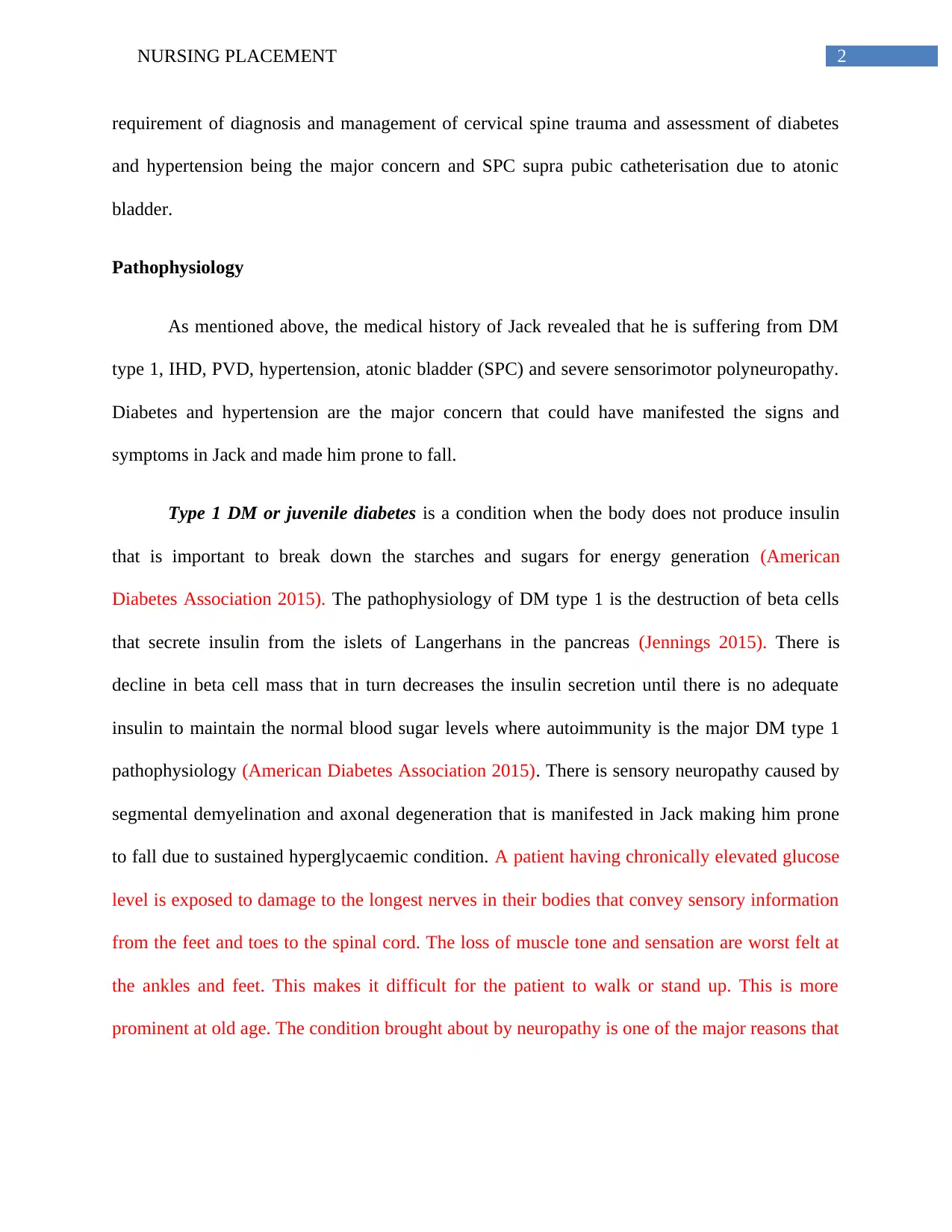
2NURSING PLACEMENT
requirement of diagnosis and management of cervical spine trauma and assessment of diabetes
and hypertension being the major concern and SPC supra pubic catheterisation due to atonic
bladder.
Pathophysiology
As mentioned above, the medical history of Jack revealed that he is suffering from DM
type 1, IHD, PVD, hypertension, atonic bladder (SPC) and severe sensorimotor polyneuropathy.
Diabetes and hypertension are the major concern that could have manifested the signs and
symptoms in Jack and made him prone to fall.
Type 1 DM or juvenile diabetes is a condition when the body does not produce insulin
that is important to break down the starches and sugars for energy generation (American
Diabetes Association 2015). The pathophysiology of DM type 1 is the destruction of beta cells
that secrete insulin from the islets of Langerhans in the pancreas (Jennings 2015). There is
decline in beta cell mass that in turn decreases the insulin secretion until there is no adequate
insulin to maintain the normal blood sugar levels where autoimmunity is the major DM type 1
pathophysiology (American Diabetes Association 2015). There is sensory neuropathy caused by
segmental demyelination and axonal degeneration that is manifested in Jack making him prone
to fall due to sustained hyperglycaemic condition. A patient having chronically elevated glucose
level is exposed to damage to the longest nerves in their bodies that convey sensory information
from the feet and toes to the spinal cord. The loss of muscle tone and sensation are worst felt at
the ankles and feet. This makes it difficult for the patient to walk or stand up. This is more
prominent at old age. The condition brought about by neuropathy is one of the major reasons that
requirement of diagnosis and management of cervical spine trauma and assessment of diabetes
and hypertension being the major concern and SPC supra pubic catheterisation due to atonic
bladder.
Pathophysiology
As mentioned above, the medical history of Jack revealed that he is suffering from DM
type 1, IHD, PVD, hypertension, atonic bladder (SPC) and severe sensorimotor polyneuropathy.
Diabetes and hypertension are the major concern that could have manifested the signs and
symptoms in Jack and made him prone to fall.
Type 1 DM or juvenile diabetes is a condition when the body does not produce insulin
that is important to break down the starches and sugars for energy generation (American
Diabetes Association 2015). The pathophysiology of DM type 1 is the destruction of beta cells
that secrete insulin from the islets of Langerhans in the pancreas (Jennings 2015). There is
decline in beta cell mass that in turn decreases the insulin secretion until there is no adequate
insulin to maintain the normal blood sugar levels where autoimmunity is the major DM type 1
pathophysiology (American Diabetes Association 2015). There is sensory neuropathy caused by
segmental demyelination and axonal degeneration that is manifested in Jack making him prone
to fall due to sustained hyperglycaemic condition. A patient having chronically elevated glucose
level is exposed to damage to the longest nerves in their bodies that convey sensory information
from the feet and toes to the spinal cord. The loss of muscle tone and sensation are worst felt at
the ankles and feet. This makes it difficult for the patient to walk or stand up. This is more
prominent at old age. The condition brought about by neuropathy is one of the major reasons that

3NURSING PLACEMENT
people with diabetes have such a high risk for falls (Atkinson, Eisenbarth and Michels 2014,
pp.69-82).
Pathophysiology of hypertension is multi-factorial and complex where kidney acts as the
major target organ and contributing factor. Arterial hypertension is the persistent systemic blood
elevation where the cardiac output is elevated or systemic vascular resistance increase. There is a
strong link between hypertension and diabetic neuropathy where hypertension acts as the
independent risk factor as RBCs and Na/K ATPase decrease. An alteration in the
microcirculation plays an important role in this regard. Hypertension leads to up-regulation of
matrix metalloproteinase (MMP) expression at the sites of myelin thinning at sensory nerve
fibers. This potentially worsens comorbid diabetes (Visser et al. 2014). This could be the
pathophysiology of hypertension in Jack with diabetes, both being intertwined conditions sharing
significant overlap in the manifestation of the underlying risks (Burnier and Wuerzner 2015,
pp.655-683).
There are macrovascular complications associated with longstanding hypertension or
diabetes which includes IHD (Ischemic Heart Disease) and PHD (American Diabetes
Association 2015). Microvascular complications include sensorimotor polyneuropathy that is
witnessed in Jack on admission.
IHD is a condition in which there is narrowing or blockage of the blood vessels that
affects the blood supply to the heart. This occurs due to cholesterol deposition on the walls of the
vessels reducing the nutrient and oxygen supply to the heart muscles that is essential for the
proper functioning of the heart. Therefore, this condition occurs when some part of the heart is
deprived of the oxygen and blood supply that can lead to heart attack (Shepard et al. 2015,
people with diabetes have such a high risk for falls (Atkinson, Eisenbarth and Michels 2014,
pp.69-82).
Pathophysiology of hypertension is multi-factorial and complex where kidney acts as the
major target organ and contributing factor. Arterial hypertension is the persistent systemic blood
elevation where the cardiac output is elevated or systemic vascular resistance increase. There is a
strong link between hypertension and diabetic neuropathy where hypertension acts as the
independent risk factor as RBCs and Na/K ATPase decrease. An alteration in the
microcirculation plays an important role in this regard. Hypertension leads to up-regulation of
matrix metalloproteinase (MMP) expression at the sites of myelin thinning at sensory nerve
fibers. This potentially worsens comorbid diabetes (Visser et al. 2014). This could be the
pathophysiology of hypertension in Jack with diabetes, both being intertwined conditions sharing
significant overlap in the manifestation of the underlying risks (Burnier and Wuerzner 2015,
pp.655-683).
There are macrovascular complications associated with longstanding hypertension or
diabetes which includes IHD (Ischemic Heart Disease) and PHD (American Diabetes
Association 2015). Microvascular complications include sensorimotor polyneuropathy that is
witnessed in Jack on admission.
IHD is a condition in which there is narrowing or blockage of the blood vessels that
affects the blood supply to the heart. This occurs due to cholesterol deposition on the walls of the
vessels reducing the nutrient and oxygen supply to the heart muscles that is essential for the
proper functioning of the heart. Therefore, this condition occurs when some part of the heart is
deprived of the oxygen and blood supply that can lead to heart attack (Shepard et al. 2015,
Secure Best Marks with AI Grader
Need help grading? Try our AI Grader for instant feedback on your assignments.
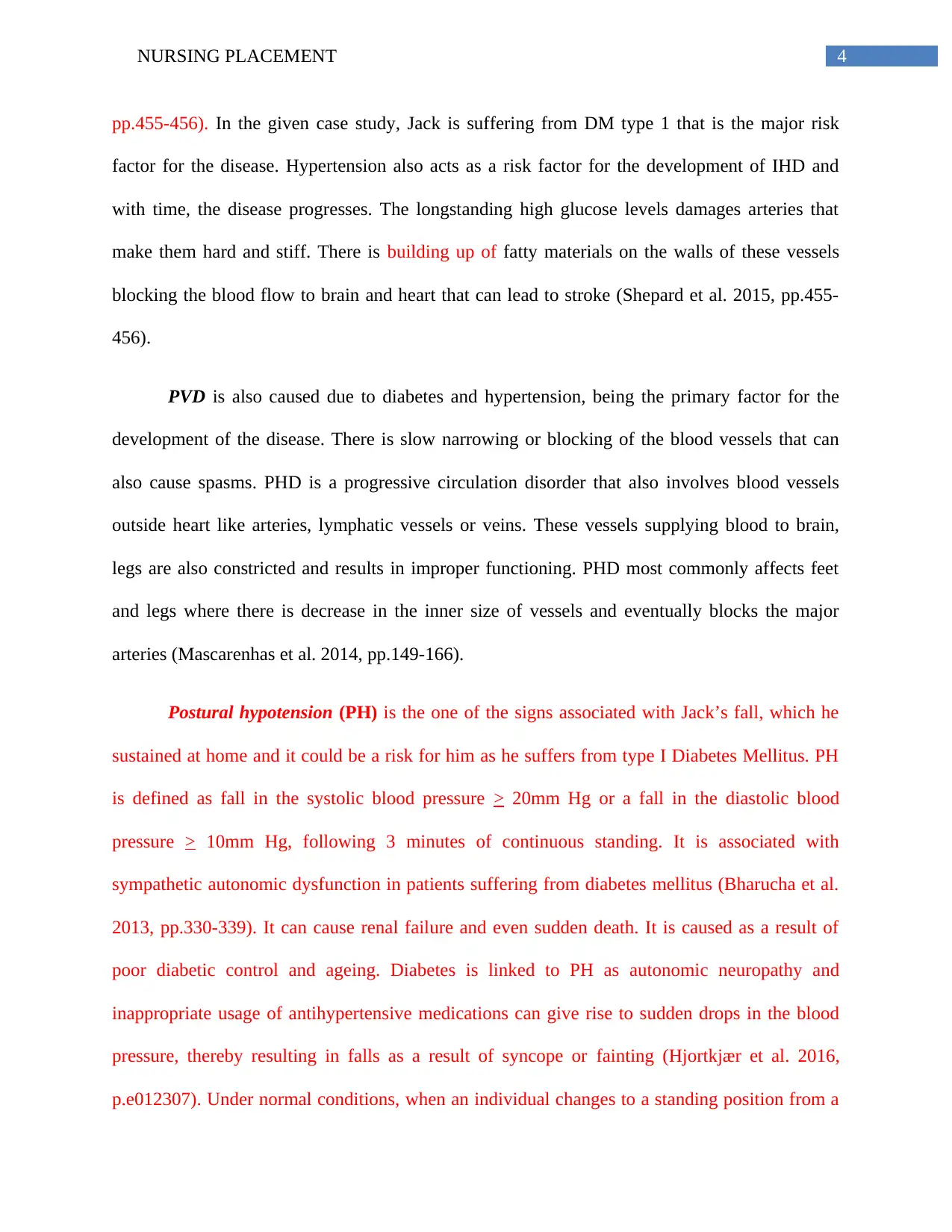
4NURSING PLACEMENT
pp.455-456). In the given case study, Jack is suffering from DM type 1 that is the major risk
factor for the disease. Hypertension also acts as a risk factor for the development of IHD and
with time, the disease progresses. The longstanding high glucose levels damages arteries that
make them hard and stiff. There is building up of fatty materials on the walls of these vessels
blocking the blood flow to brain and heart that can lead to stroke (Shepard et al. 2015, pp.455-
456).
PVD is also caused due to diabetes and hypertension, being the primary factor for the
development of the disease. There is slow narrowing or blocking of the blood vessels that can
also cause spasms. PHD is a progressive circulation disorder that also involves blood vessels
outside heart like arteries, lymphatic vessels or veins. These vessels supplying blood to brain,
legs are also constricted and results in improper functioning. PHD most commonly affects feet
and legs where there is decrease in the inner size of vessels and eventually blocks the major
arteries (Mascarenhas et al. 2014, pp.149-166).
Postural hypotension (PH) is the one of the signs associated with Jack’s fall, which he
sustained at home and it could be a risk for him as he suffers from type I Diabetes Mellitus. PH
is defined as fall in the systolic blood pressure > 20mm Hg or a fall in the diastolic blood
pressure > 10mm Hg, following 3 minutes of continuous standing. It is associated with
sympathetic autonomic dysfunction in patients suffering from diabetes mellitus (Bharucha et al.
2013, pp.330-339). It can cause renal failure and even sudden death. It is caused as a result of
poor diabetic control and ageing. Diabetes is linked to PH as autonomic neuropathy and
inappropriate usage of antihypertensive medications can give rise to sudden drops in the blood
pressure, thereby resulting in falls as a result of syncope or fainting (Hjortkjær et al. 2016,
p.e012307). Under normal conditions, when an individual changes to a standing position from a
pp.455-456). In the given case study, Jack is suffering from DM type 1 that is the major risk
factor for the disease. Hypertension also acts as a risk factor for the development of IHD and
with time, the disease progresses. The longstanding high glucose levels damages arteries that
make them hard and stiff. There is building up of fatty materials on the walls of these vessels
blocking the blood flow to brain and heart that can lead to stroke (Shepard et al. 2015, pp.455-
456).
PVD is also caused due to diabetes and hypertension, being the primary factor for the
development of the disease. There is slow narrowing or blocking of the blood vessels that can
also cause spasms. PHD is a progressive circulation disorder that also involves blood vessels
outside heart like arteries, lymphatic vessels or veins. These vessels supplying blood to brain,
legs are also constricted and results in improper functioning. PHD most commonly affects feet
and legs where there is decrease in the inner size of vessels and eventually blocks the major
arteries (Mascarenhas et al. 2014, pp.149-166).
Postural hypotension (PH) is the one of the signs associated with Jack’s fall, which he
sustained at home and it could be a risk for him as he suffers from type I Diabetes Mellitus. PH
is defined as fall in the systolic blood pressure > 20mm Hg or a fall in the diastolic blood
pressure > 10mm Hg, following 3 minutes of continuous standing. It is associated with
sympathetic autonomic dysfunction in patients suffering from diabetes mellitus (Bharucha et al.
2013, pp.330-339). It can cause renal failure and even sudden death. It is caused as a result of
poor diabetic control and ageing. Diabetes is linked to PH as autonomic neuropathy and
inappropriate usage of antihypertensive medications can give rise to sudden drops in the blood
pressure, thereby resulting in falls as a result of syncope or fainting (Hjortkjær et al. 2016,
p.e012307). Under normal conditions, when an individual changes to a standing position from a

5NURSING PLACEMENT
sitting position, the brain sends signals to the blood vessels of the legs to undergo constriction
reflexively and in an instant manner. This prevents blood to accumulate in the leg, preventing
blood and oxygen deprivation to the brain. However, in patients with diabetes mellitus, the
nerves involved in signalling send poor signals to the leg blood vessels and thereby results in fall
in blood pressure. This is a sign of sympathetic neuropathy and results in PH. However, anti-
hypertensives like diuretics and alpha-1-antagonists like terazosin and prazosin can also cause
postural hypotension. Individuals with diabetes are also at an increased risk of sustaining
dehydration. High blood glucose levels in can lead to decrease in water content of the body
resulting in dehydration. One of the symptoms of severe dehydration is fall in blood pressure,
which can cause fainting in individuals. The patient was suffering from diabetes mellitus, so one
of the reasons for his fall could be dehydration. Apart from diabetes, peripheral neuropathy can
also cause postural hypotension (Canal et al. 2013). The peripheral nervous system helps to
connect the central nervous system with the rest of the body like arms, legs, internal organs,
mouth, among others. In peripheral neuropathy the nerves associated with the connections and
the necessary signalling undergoes malfunction. These malfunctions are caused as a result of
damage to these nerves. One of the symptoms associated with peripheral neuropathy is a drop in
blood pressure, which can result in fainting. Nerve damage in peripheral neuropathy is mainly
caused by diabetes (Metzler et al. 2013, pp.2212-2219; Tsantoulas et al. 2017, p. eaam6072).
The condition of atonic bladder is also linked with poorly controlled or long-standing
diabetic condition. This condition is a urologic complication of diabetes referred as bladder
dysfunction. There are complaints of urge incontinence to decreased bladder or overactive
bladder and overflow incontinence. This is a condition faced by the patient as he had undergone
supra pubic catheterisation. Neurological destruction is linked to the development of atonic
sitting position, the brain sends signals to the blood vessels of the legs to undergo constriction
reflexively and in an instant manner. This prevents blood to accumulate in the leg, preventing
blood and oxygen deprivation to the brain. However, in patients with diabetes mellitus, the
nerves involved in signalling send poor signals to the leg blood vessels and thereby results in fall
in blood pressure. This is a sign of sympathetic neuropathy and results in PH. However, anti-
hypertensives like diuretics and alpha-1-antagonists like terazosin and prazosin can also cause
postural hypotension. Individuals with diabetes are also at an increased risk of sustaining
dehydration. High blood glucose levels in can lead to decrease in water content of the body
resulting in dehydration. One of the symptoms of severe dehydration is fall in blood pressure,
which can cause fainting in individuals. The patient was suffering from diabetes mellitus, so one
of the reasons for his fall could be dehydration. Apart from diabetes, peripheral neuropathy can
also cause postural hypotension (Canal et al. 2013). The peripheral nervous system helps to
connect the central nervous system with the rest of the body like arms, legs, internal organs,
mouth, among others. In peripheral neuropathy the nerves associated with the connections and
the necessary signalling undergoes malfunction. These malfunctions are caused as a result of
damage to these nerves. One of the symptoms associated with peripheral neuropathy is a drop in
blood pressure, which can result in fainting. Nerve damage in peripheral neuropathy is mainly
caused by diabetes (Metzler et al. 2013, pp.2212-2219; Tsantoulas et al. 2017, p. eaam6072).
The condition of atonic bladder is also linked with poorly controlled or long-standing
diabetic condition. This condition is a urologic complication of diabetes referred as bladder
dysfunction. There are complaints of urge incontinence to decreased bladder or overactive
bladder and overflow incontinence. This is a condition faced by the patient as he had undergone
supra pubic catheterisation. Neurological destruction is linked to the development of atonic

6NURSING PLACEMENT
bladder. Destruction of damaging of the nerves that are responsible for bladder control are
associated with atonic bladder condition. This may result in obstructive urinary bladder,
underactive or overactive urinary bladder. This is caused as a result of the alterations in the
physiology of the detrusor muscles, neuronal impairment and urothelial dysfunction. This is the
reason SPC supra pubic catheterisation was being administered in Jack. This could be a reason
for dehydration in Jack leading to postural hypotension and risk for falls. An overactive bladder
can cause the frequent release of urine from the body and if this fluid is not replaced, it results in
dehydration (Chu, Tsai and Hwang 2016, p.S66; Ay et al. 2013, p. E135 ).
The resulting neuropathic condition that is witnessed in Jack in sensorimotor
polyneuropathy, where he has lost the ability to feel or move due to nerve damage.
Polyneuropathy is defined as the systemic or body wide condition where the nerves are damaged
in different parts of body like nerve fibres, nerve cells and nerve coverings (Taveggia et al. 2014,
pp.242-252). Sensorimotor polyneuropathy can cause damage in nerve cells, axons and the
myelin sheaths. This damage takes place in the covering of the nerve cells that makes nerve
signals to become slow or stop working. One of the causes of sensorimotor polyneuropathy is
diabetes. Transmetatarsal amputation (TMA) is performed to preserve limb viability and is used
to treat patients with diabetic neuropathy among other medical conditions. TMA is done in cases
of forefoot ulcerations and gangrene complicated due to the presence of diabetes mellitus. The
patient had also undergone carpal tunnel surgery. This surgery relieves pressure from the median
nerve, thereby preventing carpal tunnel syndromes. Carpal tunnel syndrome causes numbness,
weakness and tingling sensations in the hand because of pressure building in the median nerve of
the wrist. Diabetes is one of the causes of carpal tunnel syndrome. Reduction in heart rate
variability (HRV) is generally associated with diabetic sensorimotor polyneuropathy. The patient
bladder. Destruction of damaging of the nerves that are responsible for bladder control are
associated with atonic bladder condition. This may result in obstructive urinary bladder,
underactive or overactive urinary bladder. This is caused as a result of the alterations in the
physiology of the detrusor muscles, neuronal impairment and urothelial dysfunction. This is the
reason SPC supra pubic catheterisation was being administered in Jack. This could be a reason
for dehydration in Jack leading to postural hypotension and risk for falls. An overactive bladder
can cause the frequent release of urine from the body and if this fluid is not replaced, it results in
dehydration (Chu, Tsai and Hwang 2016, p.S66; Ay et al. 2013, p. E135 ).
The resulting neuropathic condition that is witnessed in Jack in sensorimotor
polyneuropathy, where he has lost the ability to feel or move due to nerve damage.
Polyneuropathy is defined as the systemic or body wide condition where the nerves are damaged
in different parts of body like nerve fibres, nerve cells and nerve coverings (Taveggia et al. 2014,
pp.242-252). Sensorimotor polyneuropathy can cause damage in nerve cells, axons and the
myelin sheaths. This damage takes place in the covering of the nerve cells that makes nerve
signals to become slow or stop working. One of the causes of sensorimotor polyneuropathy is
diabetes. Transmetatarsal amputation (TMA) is performed to preserve limb viability and is used
to treat patients with diabetic neuropathy among other medical conditions. TMA is done in cases
of forefoot ulcerations and gangrene complicated due to the presence of diabetes mellitus. The
patient had also undergone carpal tunnel surgery. This surgery relieves pressure from the median
nerve, thereby preventing carpal tunnel syndromes. Carpal tunnel syndrome causes numbness,
weakness and tingling sensations in the hand because of pressure building in the median nerve of
the wrist. Diabetes is one of the causes of carpal tunnel syndrome. Reduction in heart rate
variability (HRV) is generally associated with diabetic sensorimotor polyneuropathy. The patient
Paraphrase This Document
Need a fresh take? Get an instant paraphrase of this document with our AI Paraphraser
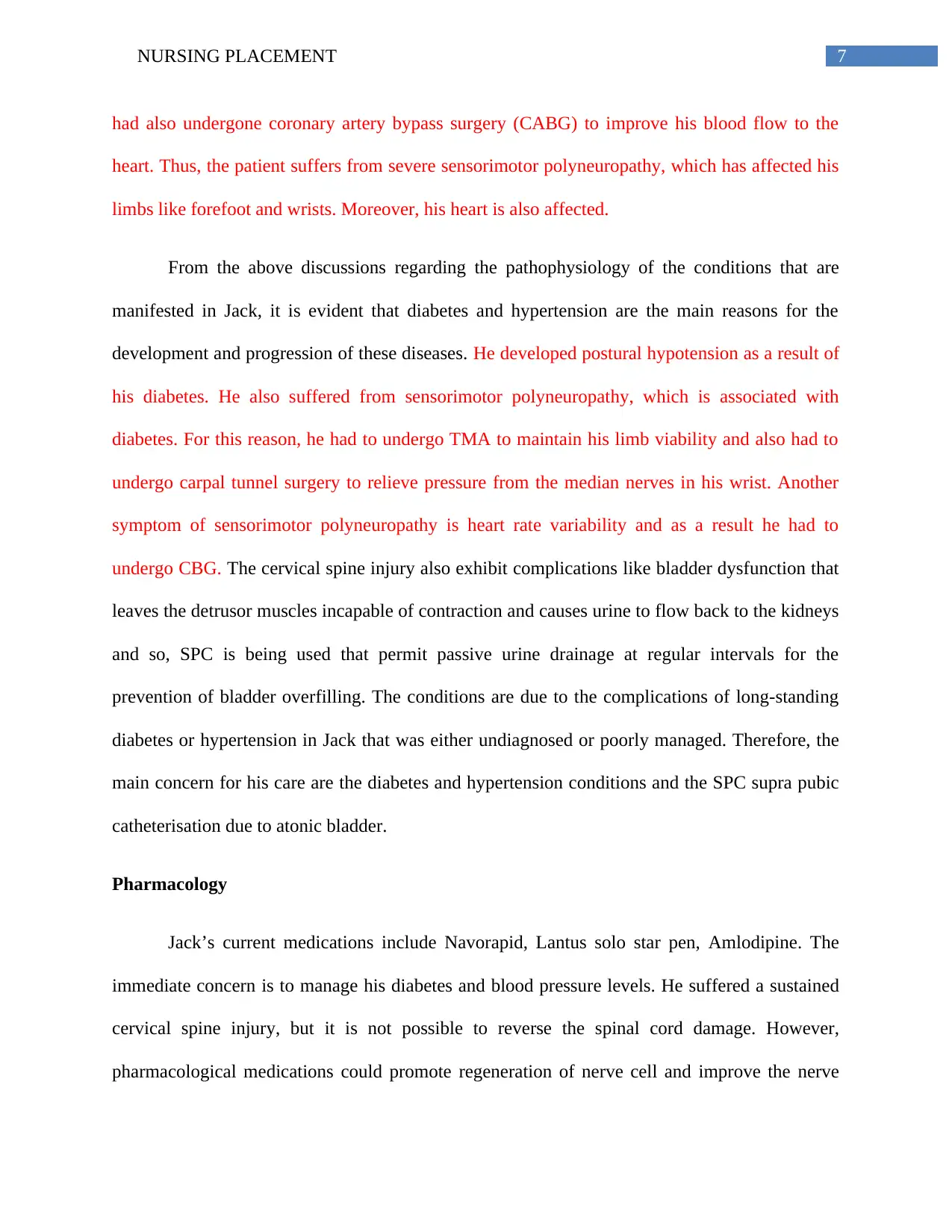
7NURSING PLACEMENT
had also undergone coronary artery bypass surgery (CABG) to improve his blood flow to the
heart. Thus, the patient suffers from severe sensorimotor polyneuropathy, which has affected his
limbs like forefoot and wrists. Moreover, his heart is also affected.
From the above discussions regarding the pathophysiology of the conditions that are
manifested in Jack, it is evident that diabetes and hypertension are the main reasons for the
development and progression of these diseases. He developed postural hypotension as a result of
his diabetes. He also suffered from sensorimotor polyneuropathy, which is associated with
diabetes. For this reason, he had to undergo TMA to maintain his limb viability and also had to
undergo carpal tunnel surgery to relieve pressure from the median nerves in his wrist. Another
symptom of sensorimotor polyneuropathy is heart rate variability and as a result he had to
undergo CBG. The cervical spine injury also exhibit complications like bladder dysfunction that
leaves the detrusor muscles incapable of contraction and causes urine to flow back to the kidneys
and so, SPC is being used that permit passive urine drainage at regular intervals for the
prevention of bladder overfilling. The conditions are due to the complications of long-standing
diabetes or hypertension in Jack that was either undiagnosed or poorly managed. Therefore, the
main concern for his care are the diabetes and hypertension conditions and the SPC supra pubic
catheterisation due to atonic bladder.
Pharmacology
Jack’s current medications include Navorapid, Lantus solo star pen, Amlodipine. The
immediate concern is to manage his diabetes and blood pressure levels. He suffered a sustained
cervical spine injury, but it is not possible to reverse the spinal cord damage. However,
pharmacological medications could promote regeneration of nerve cell and improve the nerve
had also undergone coronary artery bypass surgery (CABG) to improve his blood flow to the
heart. Thus, the patient suffers from severe sensorimotor polyneuropathy, which has affected his
limbs like forefoot and wrists. Moreover, his heart is also affected.
From the above discussions regarding the pathophysiology of the conditions that are
manifested in Jack, it is evident that diabetes and hypertension are the main reasons for the
development and progression of these diseases. He developed postural hypotension as a result of
his diabetes. He also suffered from sensorimotor polyneuropathy, which is associated with
diabetes. For this reason, he had to undergo TMA to maintain his limb viability and also had to
undergo carpal tunnel surgery to relieve pressure from the median nerves in his wrist. Another
symptom of sensorimotor polyneuropathy is heart rate variability and as a result he had to
undergo CBG. The cervical spine injury also exhibit complications like bladder dysfunction that
leaves the detrusor muscles incapable of contraction and causes urine to flow back to the kidneys
and so, SPC is being used that permit passive urine drainage at regular intervals for the
prevention of bladder overfilling. The conditions are due to the complications of long-standing
diabetes or hypertension in Jack that was either undiagnosed or poorly managed. Therefore, the
main concern for his care are the diabetes and hypertension conditions and the SPC supra pubic
catheterisation due to atonic bladder.
Pharmacology
Jack’s current medications include Navorapid, Lantus solo star pen, Amlodipine. The
immediate concern is to manage his diabetes and blood pressure levels. He suffered a sustained
cervical spine injury, but it is not possible to reverse the spinal cord damage. However,
pharmacological medications could promote regeneration of nerve cell and improve the nerve

8NURSING PLACEMENT
functioning. Therefore, the pharmacological interventions in spinal cord injury treatment is
focused on the prevention of further injury and empowering Jack to lead a productive and active
life.
The medication NovoRapid is used for the lowering of the blood sugar levels, as the
pancreas cannot produce insulin to meet the requirements of the body (Wendt et al. 2017, p.
1932296817693254). The expected outcome of this medication is to lower the blood glucose
levels as glucose cannot store or accumulated by the body for use. Novorapid stimulates the
glucose uptake in fat and skeletal muscle, inhibits the production of hepatic glucose. This
medication also inhibits proteolysis or lipolysis and enhances protein synthesis
(Davisplus.fadavis.com, 2017). It has a rapid action and onset with shorter duration as compared
to human insulin. It has a therapeutic effect of controlling hyperglycemia and so it can control
the blood glucose levels of Jack, which were found to be high as he was suffering from type I
diabetes mellitus, which results in inability of the body to produce insulin. The side effects of
this drug include hypoglycemia in the endothelial cells and have local effects like swelling,
erythema, pruritis and liposystrophy. It also has miscellaneous side effects include allergic
reactions like anaphylaxis. The contraindications of this drug are in hypoglycemia,
hypersensitivity or allergy and should be cautiously used in infection and stress. As Jack is
suffering from type 1 diabetes, this drug must be used with longer-acting insulin that includes the
precautions before using this drug for lowering the blood glucose levels. These precautions
include inadequate dosing or treatment discontinuation. Inadequate or discontinuation of
treatment can lead to diabetic ketoacidosis and hyperglycaemia. NovoRapid must not be injected
if symptoms of hypoglycaemia develop. Dose adjustment is considered following blood glucose
adjustment. Rapid onset of action of NovoRapid can be expected in the case of patients with
functioning. Therefore, the pharmacological interventions in spinal cord injury treatment is
focused on the prevention of further injury and empowering Jack to lead a productive and active
life.
The medication NovoRapid is used for the lowering of the blood sugar levels, as the
pancreas cannot produce insulin to meet the requirements of the body (Wendt et al. 2017, p.
1932296817693254). The expected outcome of this medication is to lower the blood glucose
levels as glucose cannot store or accumulated by the body for use. Novorapid stimulates the
glucose uptake in fat and skeletal muscle, inhibits the production of hepatic glucose. This
medication also inhibits proteolysis or lipolysis and enhances protein synthesis
(Davisplus.fadavis.com, 2017). It has a rapid action and onset with shorter duration as compared
to human insulin. It has a therapeutic effect of controlling hyperglycemia and so it can control
the blood glucose levels of Jack, which were found to be high as he was suffering from type I
diabetes mellitus, which results in inability of the body to produce insulin. The side effects of
this drug include hypoglycemia in the endothelial cells and have local effects like swelling,
erythema, pruritis and liposystrophy. It also has miscellaneous side effects include allergic
reactions like anaphylaxis. The contraindications of this drug are in hypoglycemia,
hypersensitivity or allergy and should be cautiously used in infection and stress. As Jack is
suffering from type 1 diabetes, this drug must be used with longer-acting insulin that includes the
precautions before using this drug for lowering the blood glucose levels. These precautions
include inadequate dosing or treatment discontinuation. Inadequate or discontinuation of
treatment can lead to diabetic ketoacidosis and hyperglycaemia. NovoRapid must not be injected
if symptoms of hypoglycaemia develop. Dose adjustment is considered following blood glucose
adjustment. Rapid onset of action of NovoRapid can be expected in the case of patients with
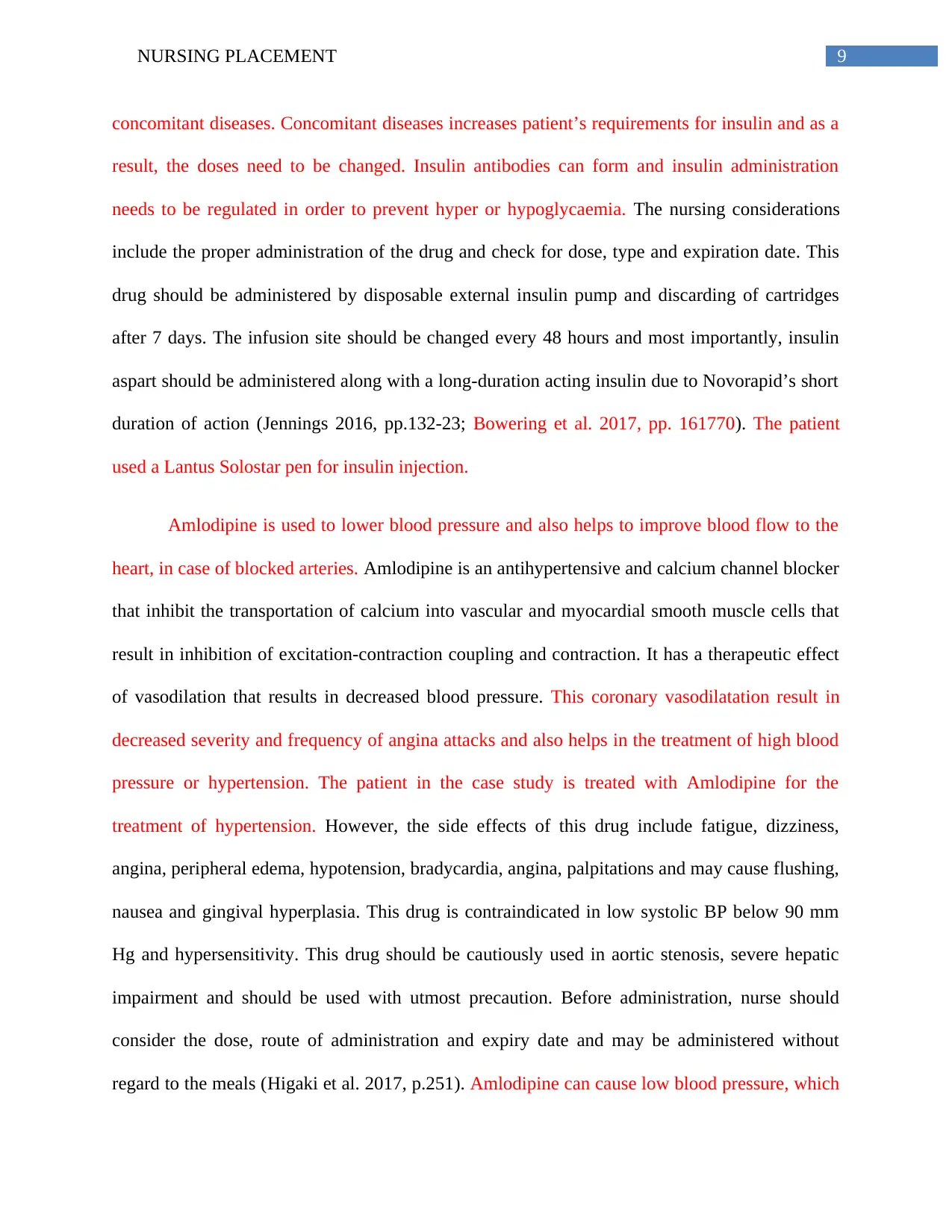
9NURSING PLACEMENT
concomitant diseases. Concomitant diseases increases patient’s requirements for insulin and as a
result, the doses need to be changed. Insulin antibodies can form and insulin administration
needs to be regulated in order to prevent hyper or hypoglycaemia. The nursing considerations
include the proper administration of the drug and check for dose, type and expiration date. This
drug should be administered by disposable external insulin pump and discarding of cartridges
after 7 days. The infusion site should be changed every 48 hours and most importantly, insulin
aspart should be administered along with a long-duration acting insulin due to Novorapid’s short
duration of action (Jennings 2016, pp.132-23; Bowering et al. 2017, pp. 161770). The patient
used a Lantus Solostar pen for insulin injection.
Amlodipine is used to lower blood pressure and also helps to improve blood flow to the
heart, in case of blocked arteries. Amlodipine is an antihypertensive and calcium channel blocker
that inhibit the transportation of calcium into vascular and myocardial smooth muscle cells that
result in inhibition of excitation-contraction coupling and contraction. It has a therapeutic effect
of vasodilation that results in decreased blood pressure. This coronary vasodilatation result in
decreased severity and frequency of angina attacks and also helps in the treatment of high blood
pressure or hypertension. The patient in the case study is treated with Amlodipine for the
treatment of hypertension. However, the side effects of this drug include fatigue, dizziness,
angina, peripheral edema, hypotension, bradycardia, angina, palpitations and may cause flushing,
nausea and gingival hyperplasia. This drug is contraindicated in low systolic BP below 90 mm
Hg and hypersensitivity. This drug should be cautiously used in aortic stenosis, severe hepatic
impairment and should be used with utmost precaution. Before administration, nurse should
consider the dose, route of administration and expiry date and may be administered without
regard to the meals (Higaki et al. 2017, p.251). Amlodipine can cause low blood pressure, which
concomitant diseases. Concomitant diseases increases patient’s requirements for insulin and as a
result, the doses need to be changed. Insulin antibodies can form and insulin administration
needs to be regulated in order to prevent hyper or hypoglycaemia. The nursing considerations
include the proper administration of the drug and check for dose, type and expiration date. This
drug should be administered by disposable external insulin pump and discarding of cartridges
after 7 days. The infusion site should be changed every 48 hours and most importantly, insulin
aspart should be administered along with a long-duration acting insulin due to Novorapid’s short
duration of action (Jennings 2016, pp.132-23; Bowering et al. 2017, pp. 161770). The patient
used a Lantus Solostar pen for insulin injection.
Amlodipine is used to lower blood pressure and also helps to improve blood flow to the
heart, in case of blocked arteries. Amlodipine is an antihypertensive and calcium channel blocker
that inhibit the transportation of calcium into vascular and myocardial smooth muscle cells that
result in inhibition of excitation-contraction coupling and contraction. It has a therapeutic effect
of vasodilation that results in decreased blood pressure. This coronary vasodilatation result in
decreased severity and frequency of angina attacks and also helps in the treatment of high blood
pressure or hypertension. The patient in the case study is treated with Amlodipine for the
treatment of hypertension. However, the side effects of this drug include fatigue, dizziness,
angina, peripheral edema, hypotension, bradycardia, angina, palpitations and may cause flushing,
nausea and gingival hyperplasia. This drug is contraindicated in low systolic BP below 90 mm
Hg and hypersensitivity. This drug should be cautiously used in aortic stenosis, severe hepatic
impairment and should be used with utmost precaution. Before administration, nurse should
consider the dose, route of administration and expiry date and may be administered without
regard to the meals (Higaki et al. 2017, p.251). Amlodipine can cause low blood pressure, which
Secure Best Marks with AI Grader
Need help grading? Try our AI Grader for instant feedback on your assignments.

10NURSING PLACEMENT
can result in dizziness and fainting. Thus, it is necessary to monitor the blood pressure before its
administration.
Lantus solostar pen or insulin glargine has therapeutic effect by lowering of the blood
glucose levels through stimulation of glucose uptake in the fat and skeletal muscles. It inhibits
the production of hepatic glucose and inhibition of lipolysis, proteolysis. It also enhances protein
synthesis and control hyperglycemia. The adverse reactions of this drug are hypoglycemia,
swelling, erythema, lipodystrophy and pruritis and can cause hypersensitivity including
anaphylaxis. Before administration, the nurse should consider the dosage and administration of
this drug as medication errors are common in insulin. Insulin syringes should be properly used
and there should be no mixing of the drug with other insulin solutions. The drug should be
administered subcutaneously once daily at the same time each day and should not be
administered with insulin pumps or IV (Rosselli et al. 2015, p.251; Ranjan et al. 2016, p.410-
418).
Investigations
The assessment of the vital signs and diagnostic tests or activities is important for the
patient-center care and planning. The patient history, vital signs, laboratory tests and physical
examination is important for the proper planning of care and disease management. Vital signs of
a patient are important for the healthcare professionals to determine the treatment options and
provide critical information to make the decisions for treatment and management. In the given
case study, after admission to the hospital, Jack was diagnosed with type 1 DM, hypertension
through the diagnostic testing of blood. He suffered a serious fall at his home as a result of
postural hypotension, which indicates that he had these medical conditions prior to hospital
can result in dizziness and fainting. Thus, it is necessary to monitor the blood pressure before its
administration.
Lantus solostar pen or insulin glargine has therapeutic effect by lowering of the blood
glucose levels through stimulation of glucose uptake in the fat and skeletal muscles. It inhibits
the production of hepatic glucose and inhibition of lipolysis, proteolysis. It also enhances protein
synthesis and control hyperglycemia. The adverse reactions of this drug are hypoglycemia,
swelling, erythema, lipodystrophy and pruritis and can cause hypersensitivity including
anaphylaxis. Before administration, the nurse should consider the dosage and administration of
this drug as medication errors are common in insulin. Insulin syringes should be properly used
and there should be no mixing of the drug with other insulin solutions. The drug should be
administered subcutaneously once daily at the same time each day and should not be
administered with insulin pumps or IV (Rosselli et al. 2015, p.251; Ranjan et al. 2016, p.410-
418).
Investigations
The assessment of the vital signs and diagnostic tests or activities is important for the
patient-center care and planning. The patient history, vital signs, laboratory tests and physical
examination is important for the proper planning of care and disease management. Vital signs of
a patient are important for the healthcare professionals to determine the treatment options and
provide critical information to make the decisions for treatment and management. In the given
case study, after admission to the hospital, Jack was diagnosed with type 1 DM, hypertension
through the diagnostic testing of blood. He suffered a serious fall at his home as a result of
postural hypotension, which indicates that he had these medical conditions prior to hospital

11NURSING PLACEMENT
admission but was diagnosed after admission. Everyday Jacjkson was monitored thrice daily to
check his blood sugar level before administration of insulin. It is necessary to check blood
glucose levels before insulin administration, since, insulin administration following low blood
glucose levels can give rise to serious health concerns and can also give rise to hypoglycaemia.
Monitoring of blood glucose levels is essential to guide the therapy for diabetic patients. Patients
with Type 1 diabetes are usually given 2 injections of two types of insulin per day. This
generally progresses to 3-4 injections of different types of insulin. Types of insulin depends on
blood glucose levels. Monitoring of blood glucose levels is essential in order to modulate the
insulin dosage, activity and food consumption. The main reason for admission was fall, so X ray
was done to look for any kind of injury that he has sustained after cervical spine injury. The
patient’s past medical history revealed that he suffers from hypertension and diabetes. His blood
pressure and blood glucose levels had to be monitored in the aged care, so that proper
medications and nursing implementations were carried out to provide sufficient care to the
patient. In the aged care, the patient’s blood pressure was checked regularly. This was because,
he was suffering from hypertension, moreover, high blood glucose levels can also result in high
blood pressure. Jack also suffered from heart problems and hypertension is a major risk factor for
the development of ischemic heart disease. Therefore, it is necessary to monitor blood pressure,
in order to prevent ischemic heart disease. Measurement of blood pressure is also needed in
patients suffering from postural hypotension, which can increase the risk of falls. High blood
pressure can also intensify the symptoms in patients suffering from angina, which in turn can
increase the risk of heart attack. As Jack is hypertensive and sustained cervical spine injury, x-
ray and ECG are important to assess his heart condition and any kind of internal injury after
falling (Forbes and Watt 2015, pp.60). ECG can detect patterns in heart beats to monitor proper
admission but was diagnosed after admission. Everyday Jacjkson was monitored thrice daily to
check his blood sugar level before administration of insulin. It is necessary to check blood
glucose levels before insulin administration, since, insulin administration following low blood
glucose levels can give rise to serious health concerns and can also give rise to hypoglycaemia.
Monitoring of blood glucose levels is essential to guide the therapy for diabetic patients. Patients
with Type 1 diabetes are usually given 2 injections of two types of insulin per day. This
generally progresses to 3-4 injections of different types of insulin. Types of insulin depends on
blood glucose levels. Monitoring of blood glucose levels is essential in order to modulate the
insulin dosage, activity and food consumption. The main reason for admission was fall, so X ray
was done to look for any kind of injury that he has sustained after cervical spine injury. The
patient’s past medical history revealed that he suffers from hypertension and diabetes. His blood
pressure and blood glucose levels had to be monitored in the aged care, so that proper
medications and nursing implementations were carried out to provide sufficient care to the
patient. In the aged care, the patient’s blood pressure was checked regularly. This was because,
he was suffering from hypertension, moreover, high blood glucose levels can also result in high
blood pressure. Jack also suffered from heart problems and hypertension is a major risk factor for
the development of ischemic heart disease. Therefore, it is necessary to monitor blood pressure,
in order to prevent ischemic heart disease. Measurement of blood pressure is also needed in
patients suffering from postural hypotension, which can increase the risk of falls. High blood
pressure can also intensify the symptoms in patients suffering from angina, which in turn can
increase the risk of heart attack. As Jack is hypertensive and sustained cervical spine injury, x-
ray and ECG are important to assess his heart condition and any kind of internal injury after
falling (Forbes and Watt 2015, pp.60). ECG can detect patterns in heart beats to monitor proper
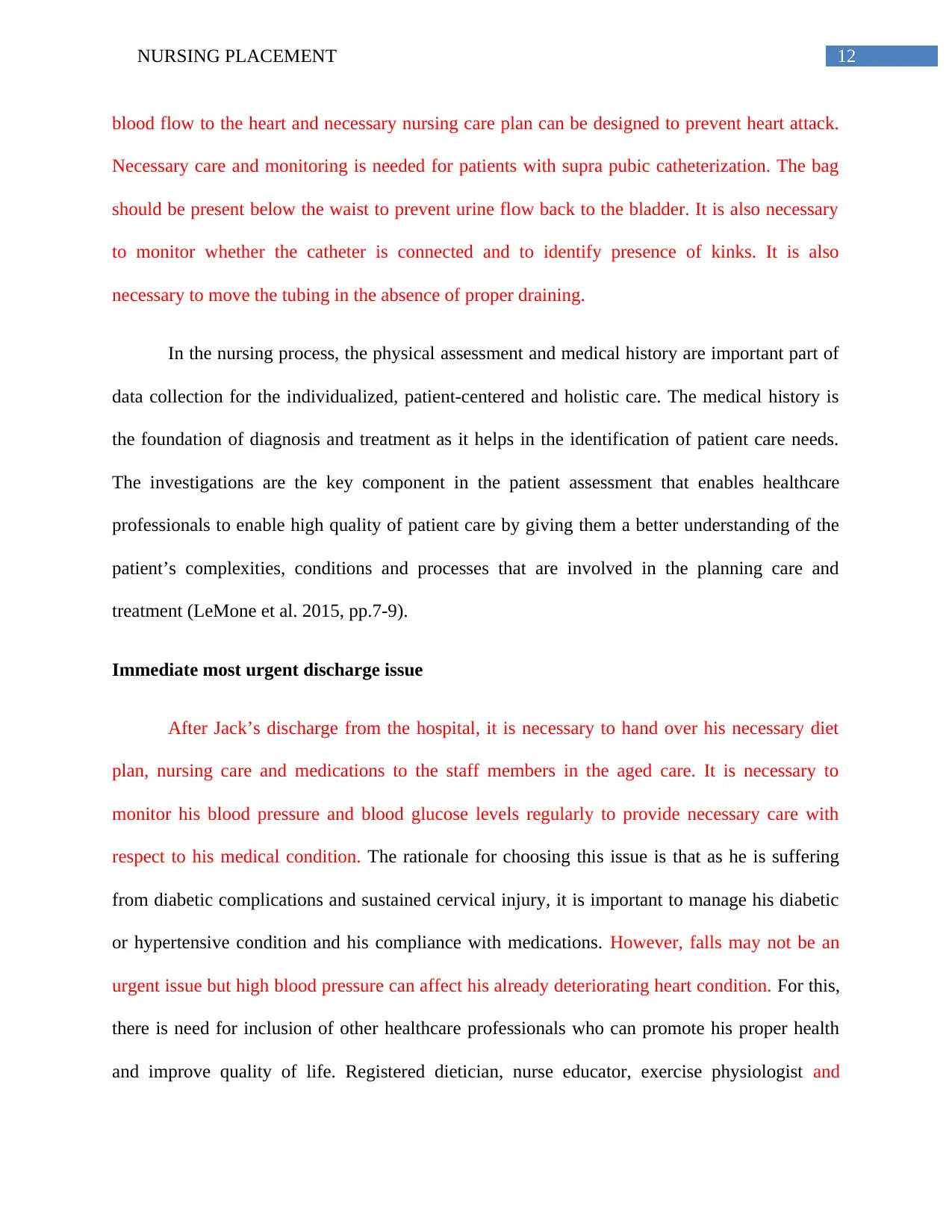
12NURSING PLACEMENT
blood flow to the heart and necessary nursing care plan can be designed to prevent heart attack.
Necessary care and monitoring is needed for patients with supra pubic catheterization. The bag
should be present below the waist to prevent urine flow back to the bladder. It is also necessary
to monitor whether the catheter is connected and to identify presence of kinks. It is also
necessary to move the tubing in the absence of proper draining.
In the nursing process, the physical assessment and medical history are important part of
data collection for the individualized, patient-centered and holistic care. The medical history is
the foundation of diagnosis and treatment as it helps in the identification of patient care needs.
The investigations are the key component in the patient assessment that enables healthcare
professionals to enable high quality of patient care by giving them a better understanding of the
patient’s complexities, conditions and processes that are involved in the planning care and
treatment (LeMone et al. 2015, pp.7-9).
Immediate most urgent discharge issue
After Jack’s discharge from the hospital, it is necessary to hand over his necessary diet
plan, nursing care and medications to the staff members in the aged care. It is necessary to
monitor his blood pressure and blood glucose levels regularly to provide necessary care with
respect to his medical condition. The rationale for choosing this issue is that as he is suffering
from diabetic complications and sustained cervical injury, it is important to manage his diabetic
or hypertensive condition and his compliance with medications. However, falls may not be an
urgent issue but high blood pressure can affect his already deteriorating heart condition. For this,
there is need for inclusion of other healthcare professionals who can promote his proper health
and improve quality of life. Registered dietician, nurse educator, exercise physiologist and
blood flow to the heart and necessary nursing care plan can be designed to prevent heart attack.
Necessary care and monitoring is needed for patients with supra pubic catheterization. The bag
should be present below the waist to prevent urine flow back to the bladder. It is also necessary
to monitor whether the catheter is connected and to identify presence of kinks. It is also
necessary to move the tubing in the absence of proper draining.
In the nursing process, the physical assessment and medical history are important part of
data collection for the individualized, patient-centered and holistic care. The medical history is
the foundation of diagnosis and treatment as it helps in the identification of patient care needs.
The investigations are the key component in the patient assessment that enables healthcare
professionals to enable high quality of patient care by giving them a better understanding of the
patient’s complexities, conditions and processes that are involved in the planning care and
treatment (LeMone et al. 2015, pp.7-9).
Immediate most urgent discharge issue
After Jack’s discharge from the hospital, it is necessary to hand over his necessary diet
plan, nursing care and medications to the staff members in the aged care. It is necessary to
monitor his blood pressure and blood glucose levels regularly to provide necessary care with
respect to his medical condition. The rationale for choosing this issue is that as he is suffering
from diabetic complications and sustained cervical injury, it is important to manage his diabetic
or hypertensive condition and his compliance with medications. However, falls may not be an
urgent issue but high blood pressure can affect his already deteriorating heart condition. For this,
there is need for inclusion of other healthcare professionals who can promote his proper health
and improve quality of life. Registered dietician, nurse educator, exercise physiologist and
Paraphrase This Document
Need a fresh take? Get an instant paraphrase of this document with our AI Paraphraser
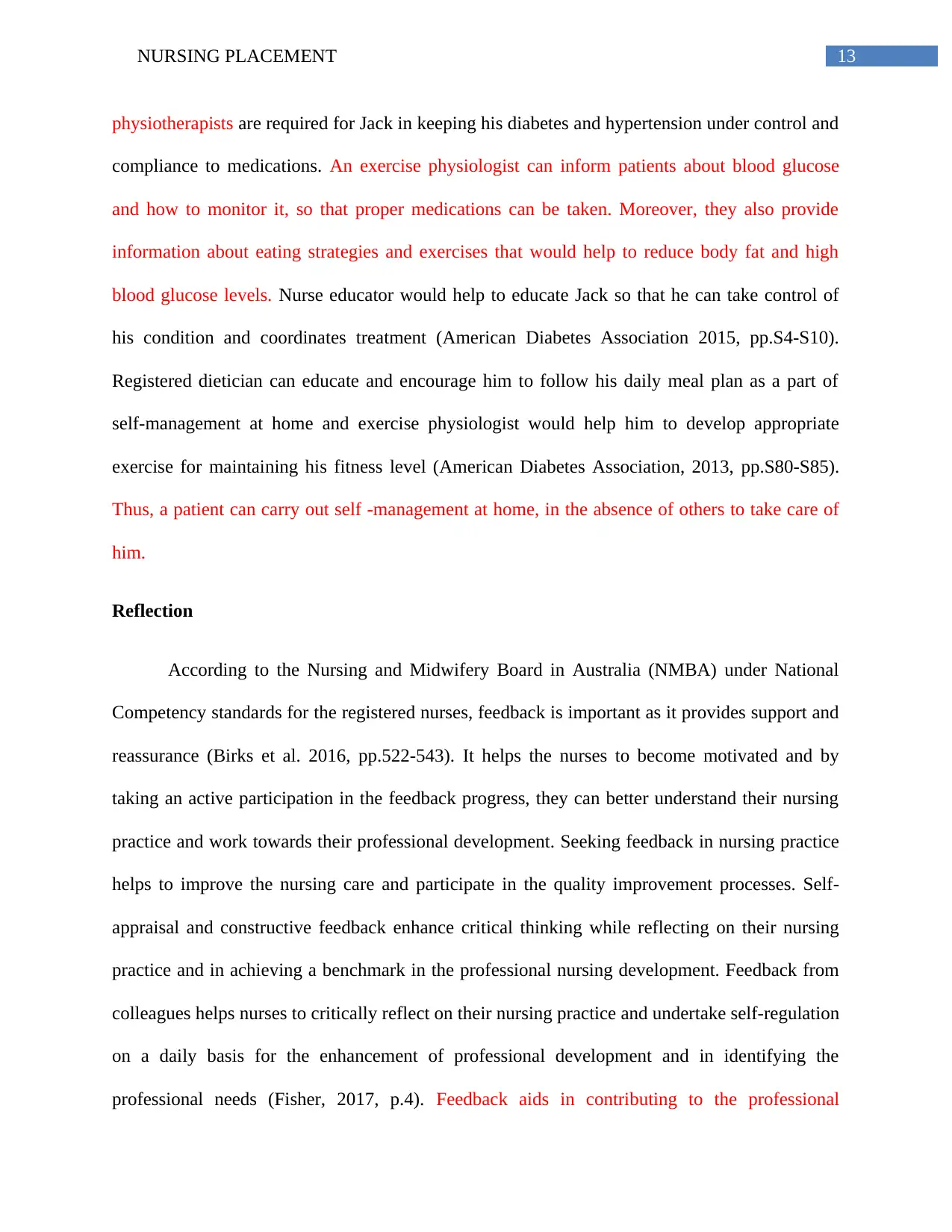
13NURSING PLACEMENT
physiotherapists are required for Jack in keeping his diabetes and hypertension under control and
compliance to medications. An exercise physiologist can inform patients about blood glucose
and how to monitor it, so that proper medications can be taken. Moreover, they also provide
information about eating strategies and exercises that would help to reduce body fat and high
blood glucose levels. Nurse educator would help to educate Jack so that he can take control of
his condition and coordinates treatment (American Diabetes Association 2015, pp.S4-S10).
Registered dietician can educate and encourage him to follow his daily meal plan as a part of
self-management at home and exercise physiologist would help him to develop appropriate
exercise for maintaining his fitness level (American Diabetes Association, 2013, pp.S80-S85).
Thus, a patient can carry out self -management at home, in the absence of others to take care of
him.
Reflection
According to the Nursing and Midwifery Board in Australia (NMBA) under National
Competency standards for the registered nurses, feedback is important as it provides support and
reassurance (Birks et al. 2016, pp.522-543). It helps the nurses to become motivated and by
taking an active participation in the feedback progress, they can better understand their nursing
practice and work towards their professional development. Seeking feedback in nursing practice
helps to improve the nursing care and participate in the quality improvement processes. Self-
appraisal and constructive feedback enhance critical thinking while reflecting on their nursing
practice and in achieving a benchmark in the professional nursing development. Feedback from
colleagues helps nurses to critically reflect on their nursing practice and undertake self-regulation
on a daily basis for the enhancement of professional development and in identifying the
professional needs (Fisher, 2017, p.4). Feedback aids in contributing to the professional
physiotherapists are required for Jack in keeping his diabetes and hypertension under control and
compliance to medications. An exercise physiologist can inform patients about blood glucose
and how to monitor it, so that proper medications can be taken. Moreover, they also provide
information about eating strategies and exercises that would help to reduce body fat and high
blood glucose levels. Nurse educator would help to educate Jack so that he can take control of
his condition and coordinates treatment (American Diabetes Association 2015, pp.S4-S10).
Registered dietician can educate and encourage him to follow his daily meal plan as a part of
self-management at home and exercise physiologist would help him to develop appropriate
exercise for maintaining his fitness level (American Diabetes Association, 2013, pp.S80-S85).
Thus, a patient can carry out self -management at home, in the absence of others to take care of
him.
Reflection
According to the Nursing and Midwifery Board in Australia (NMBA) under National
Competency standards for the registered nurses, feedback is important as it provides support and
reassurance (Birks et al. 2016, pp.522-543). It helps the nurses to become motivated and by
taking an active participation in the feedback progress, they can better understand their nursing
practice and work towards their professional development. Seeking feedback in nursing practice
helps to improve the nursing care and participate in the quality improvement processes. Self-
appraisal and constructive feedback enhance critical thinking while reflecting on their nursing
practice and in achieving a benchmark in the professional nursing development. Feedback from
colleagues helps nurses to critically reflect on their nursing practice and undertake self-regulation
on a daily basis for the enhancement of professional development and in identifying the
professional needs (Fisher, 2017, p.4). Feedback aids in contributing to the professional
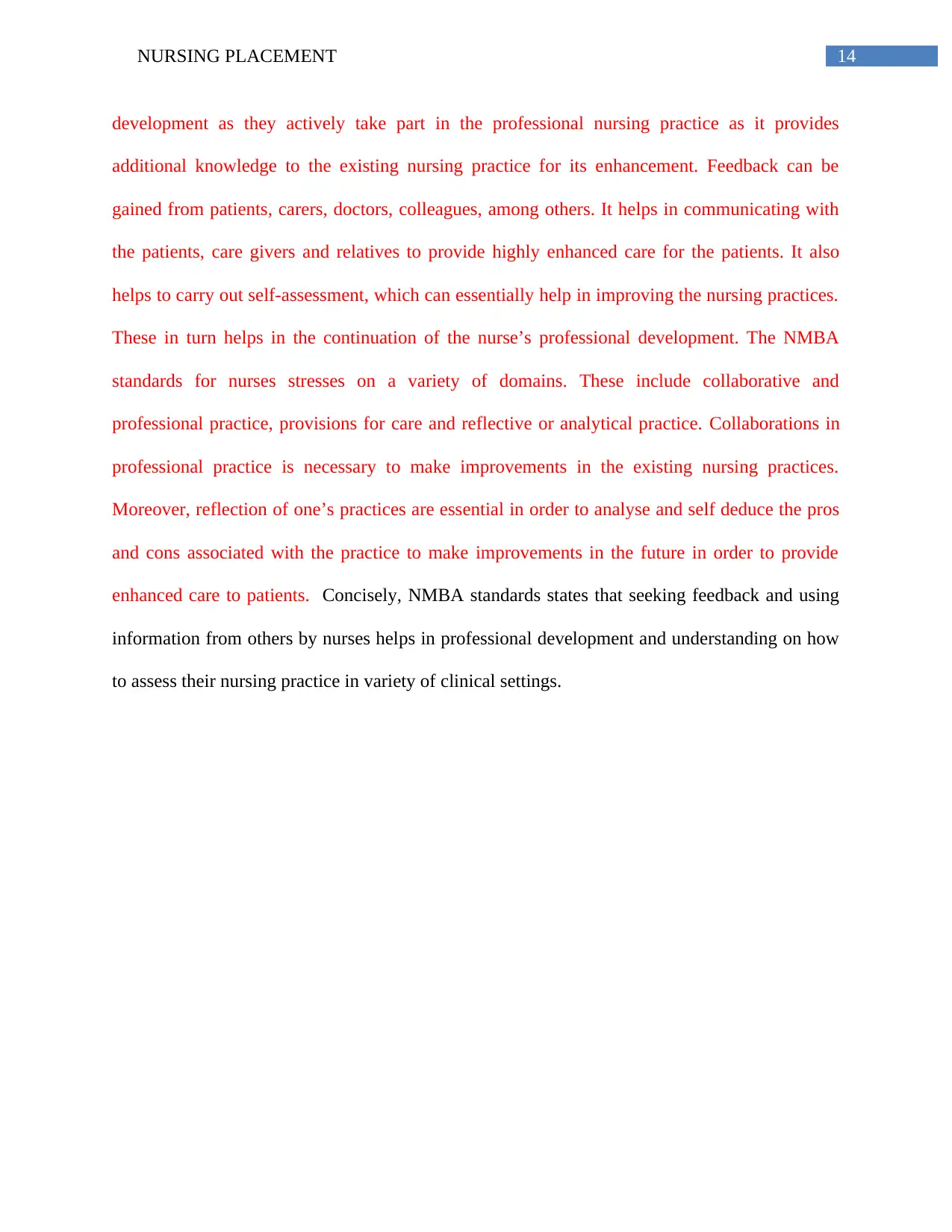
14NURSING PLACEMENT
development as they actively take part in the professional nursing practice as it provides
additional knowledge to the existing nursing practice for its enhancement. Feedback can be
gained from patients, carers, doctors, colleagues, among others. It helps in communicating with
the patients, care givers and relatives to provide highly enhanced care for the patients. It also
helps to carry out self-assessment, which can essentially help in improving the nursing practices.
These in turn helps in the continuation of the nurse’s professional development. The NMBA
standards for nurses stresses on a variety of domains. These include collaborative and
professional practice, provisions for care and reflective or analytical practice. Collaborations in
professional practice is necessary to make improvements in the existing nursing practices.
Moreover, reflection of one’s practices are essential in order to analyse and self deduce the pros
and cons associated with the practice to make improvements in the future in order to provide
enhanced care to patients. Concisely, NMBA standards states that seeking feedback and using
information from others by nurses helps in professional development and understanding on how
to assess their nursing practice in variety of clinical settings.
development as they actively take part in the professional nursing practice as it provides
additional knowledge to the existing nursing practice for its enhancement. Feedback can be
gained from patients, carers, doctors, colleagues, among others. It helps in communicating with
the patients, care givers and relatives to provide highly enhanced care for the patients. It also
helps to carry out self-assessment, which can essentially help in improving the nursing practices.
These in turn helps in the continuation of the nurse’s professional development. The NMBA
standards for nurses stresses on a variety of domains. These include collaborative and
professional practice, provisions for care and reflective or analytical practice. Collaborations in
professional practice is necessary to make improvements in the existing nursing practices.
Moreover, reflection of one’s practices are essential in order to analyse and self deduce the pros
and cons associated with the practice to make improvements in the future in order to provide
enhanced care to patients. Concisely, NMBA standards states that seeking feedback and using
information from others by nurses helps in professional development and understanding on how
to assess their nursing practice in variety of clinical settings.

15NURSING PLACEMENT
References
American Diabetes Association, 2013. Executive summary: Standards of medical care in
diabetes—2013. Diabetes care, 36(Supplement 1), pp.S4-S10.
American Diabetes Association, 2015. 13. Diabetes Care in the Hospital, Nursing Home, and
Skilled Nursing Facility. Diabetes Care, 38(Supplement 1), pp.S80-S85.
Atkinson, M.A., Eisenbarth, G.S. and Michels, A.W., 2014. Type 1 diabetes. The
Lancet, 383(9911), pp.69-82.
Ay, A., Demir, A., Kismet, K., Emir, L. and Ertas, E., 2013. Idiopathic giant atonic bladder
(6000 mL in volume) present for 15 years with no urinary symptoms. Canadian Urological
Association Journal, 7(1-2), p.E135.
Bharucha, A.E., Batey-Schaefer, B., Cleary, P.A., Murray, J.A., Cowie, C., Lorenzi, G., Driscoll,
M., Harth, J., Larkin, M., Christofi, M. and Bayless, M., 2015. Delayed gastric emptying is
associated with early and long-term hyperglycemia in type 1 diabetes
mellitus. Gastroenterology, 149(2), pp.330-339.
Birks, M., Davis, J., Smithson, J. and Cant, R., 2016. Registered nurse scope of practice in
Australia: an integrative review of the literature. Contemporary nurse, 52(5), pp.522-543.
Bowering, K., Case, C., Harvey, J., Reeves, M., Sampson, M., Strzinek, R., Bretler, D.M., Bang,
R.B. and Bode, B.W., 2017. Faster Aspart Versus Insulin Aspart As Part of a Basal-Bolus
References
American Diabetes Association, 2013. Executive summary: Standards of medical care in
diabetes—2013. Diabetes care, 36(Supplement 1), pp.S4-S10.
American Diabetes Association, 2015. 13. Diabetes Care in the Hospital, Nursing Home, and
Skilled Nursing Facility. Diabetes Care, 38(Supplement 1), pp.S80-S85.
Atkinson, M.A., Eisenbarth, G.S. and Michels, A.W., 2014. Type 1 diabetes. The
Lancet, 383(9911), pp.69-82.
Ay, A., Demir, A., Kismet, K., Emir, L. and Ertas, E., 2013. Idiopathic giant atonic bladder
(6000 mL in volume) present for 15 years with no urinary symptoms. Canadian Urological
Association Journal, 7(1-2), p.E135.
Bharucha, A.E., Batey-Schaefer, B., Cleary, P.A., Murray, J.A., Cowie, C., Lorenzi, G., Driscoll,
M., Harth, J., Larkin, M., Christofi, M. and Bayless, M., 2015. Delayed gastric emptying is
associated with early and long-term hyperglycemia in type 1 diabetes
mellitus. Gastroenterology, 149(2), pp.330-339.
Birks, M., Davis, J., Smithson, J. and Cant, R., 2016. Registered nurse scope of practice in
Australia: an integrative review of the literature. Contemporary nurse, 52(5), pp.522-543.
Bowering, K., Case, C., Harvey, J., Reeves, M., Sampson, M., Strzinek, R., Bretler, D.M., Bang,
R.B. and Bode, B.W., 2017. Faster Aspart Versus Insulin Aspart As Part of a Basal-Bolus
Secure Best Marks with AI Grader
Need help grading? Try our AI Grader for instant feedback on your assignments.
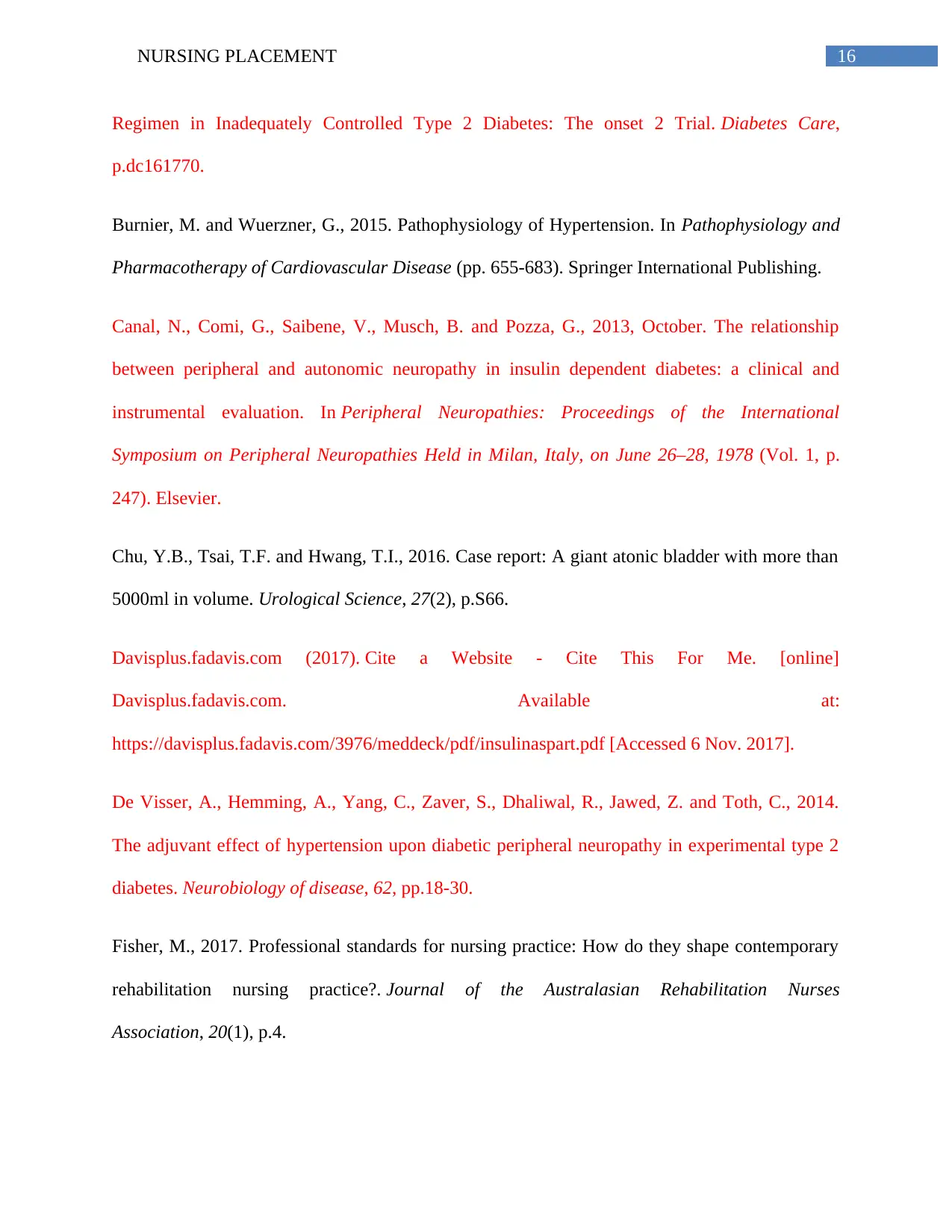
16NURSING PLACEMENT
Regimen in Inadequately Controlled Type 2 Diabetes: The onset 2 Trial. Diabetes Care,
p.dc161770.
Burnier, M. and Wuerzner, G., 2015. Pathophysiology of Hypertension. In Pathophysiology and
Pharmacotherapy of Cardiovascular Disease (pp. 655-683). Springer International Publishing.
Canal, N., Comi, G., Saibene, V., Musch, B. and Pozza, G., 2013, October. The relationship
between peripheral and autonomic neuropathy in insulin dependent diabetes: a clinical and
instrumental evaluation. In Peripheral Neuropathies: Proceedings of the International
Symposium on Peripheral Neuropathies Held in Milan, Italy, on June 26–28, 1978 (Vol. 1, p.
247). Elsevier.
Chu, Y.B., Tsai, T.F. and Hwang, T.I., 2016. Case report: A giant atonic bladder with more than
5000ml in volume. Urological Science, 27(2), p.S66.
Davisplus.fadavis.com (2017). Cite a Website - Cite This For Me. [online]
Davisplus.fadavis.com. Available at:
https://davisplus.fadavis.com/3976/meddeck/pdf/insulinaspart.pdf [Accessed 6 Nov. 2017].
De Visser, A., Hemming, A., Yang, C., Zaver, S., Dhaliwal, R., Jawed, Z. and Toth, C., 2014.
The adjuvant effect of hypertension upon diabetic peripheral neuropathy in experimental type 2
diabetes. Neurobiology of disease, 62, pp.18-30.
Fisher, M., 2017. Professional standards for nursing practice: How do they shape contemporary
rehabilitation nursing practice?. Journal of the Australasian Rehabilitation Nurses
Association, 20(1), p.4.
Regimen in Inadequately Controlled Type 2 Diabetes: The onset 2 Trial. Diabetes Care,
p.dc161770.
Burnier, M. and Wuerzner, G., 2015. Pathophysiology of Hypertension. In Pathophysiology and
Pharmacotherapy of Cardiovascular Disease (pp. 655-683). Springer International Publishing.
Canal, N., Comi, G., Saibene, V., Musch, B. and Pozza, G., 2013, October. The relationship
between peripheral and autonomic neuropathy in insulin dependent diabetes: a clinical and
instrumental evaluation. In Peripheral Neuropathies: Proceedings of the International
Symposium on Peripheral Neuropathies Held in Milan, Italy, on June 26–28, 1978 (Vol. 1, p.
247). Elsevier.
Chu, Y.B., Tsai, T.F. and Hwang, T.I., 2016. Case report: A giant atonic bladder with more than
5000ml in volume. Urological Science, 27(2), p.S66.
Davisplus.fadavis.com (2017). Cite a Website - Cite This For Me. [online]
Davisplus.fadavis.com. Available at:
https://davisplus.fadavis.com/3976/meddeck/pdf/insulinaspart.pdf [Accessed 6 Nov. 2017].
De Visser, A., Hemming, A., Yang, C., Zaver, S., Dhaliwal, R., Jawed, Z. and Toth, C., 2014.
The adjuvant effect of hypertension upon diabetic peripheral neuropathy in experimental type 2
diabetes. Neurobiology of disease, 62, pp.18-30.
Fisher, M., 2017. Professional standards for nursing practice: How do they shape contemporary
rehabilitation nursing practice?. Journal of the Australasian Rehabilitation Nurses
Association, 20(1), p.4.
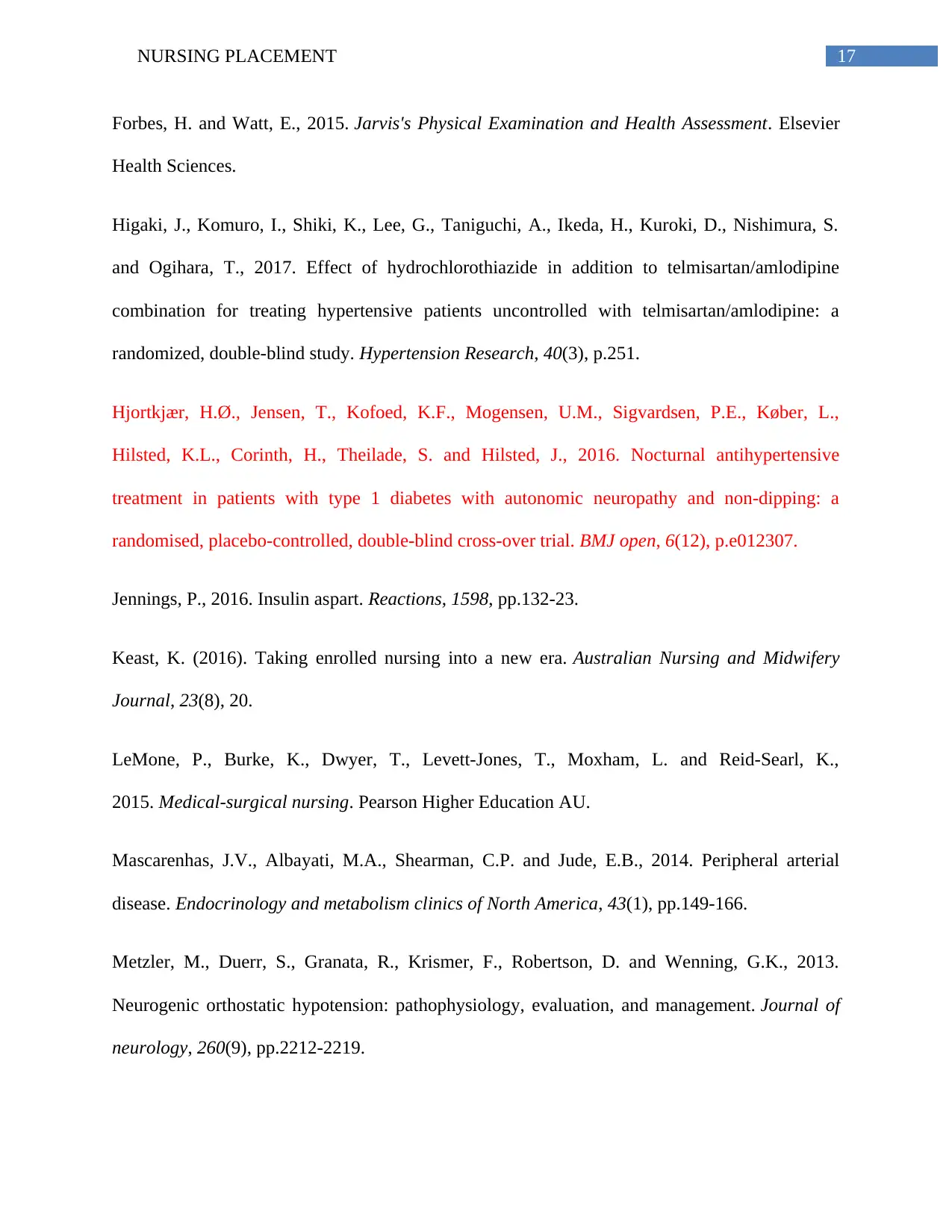
17NURSING PLACEMENT
Forbes, H. and Watt, E., 2015. Jarvis's Physical Examination and Health Assessment. Elsevier
Health Sciences.
Higaki, J., Komuro, I., Shiki, K., Lee, G., Taniguchi, A., Ikeda, H., Kuroki, D., Nishimura, S.
and Ogihara, T., 2017. Effect of hydrochlorothiazide in addition to telmisartan/amlodipine
combination for treating hypertensive patients uncontrolled with telmisartan/amlodipine: a
randomized, double-blind study. Hypertension Research, 40(3), p.251.
Hjortkjær, H.Ø., Jensen, T., Kofoed, K.F., Mogensen, U.M., Sigvardsen, P.E., Køber, L.,
Hilsted, K.L., Corinth, H., Theilade, S. and Hilsted, J., 2016. Nocturnal antihypertensive
treatment in patients with type 1 diabetes with autonomic neuropathy and non-dipping: a
randomised, placebo-controlled, double-blind cross-over trial. BMJ open, 6(12), p.e012307.
Jennings, P., 2016. Insulin aspart. Reactions, 1598, pp.132-23.
Keast, K. (2016). Taking enrolled nursing into a new era. Australian Nursing and Midwifery
Journal, 23(8), 20.
LeMone, P., Burke, K., Dwyer, T., Levett-Jones, T., Moxham, L. and Reid-Searl, K.,
2015. Medical-surgical nursing. Pearson Higher Education AU.
Mascarenhas, J.V., Albayati, M.A., Shearman, C.P. and Jude, E.B., 2014. Peripheral arterial
disease. Endocrinology and metabolism clinics of North America, 43(1), pp.149-166.
Metzler, M., Duerr, S., Granata, R., Krismer, F., Robertson, D. and Wenning, G.K., 2013.
Neurogenic orthostatic hypotension: pathophysiology, evaluation, and management. Journal of
neurology, 260(9), pp.2212-2219.
Forbes, H. and Watt, E., 2015. Jarvis's Physical Examination and Health Assessment. Elsevier
Health Sciences.
Higaki, J., Komuro, I., Shiki, K., Lee, G., Taniguchi, A., Ikeda, H., Kuroki, D., Nishimura, S.
and Ogihara, T., 2017. Effect of hydrochlorothiazide in addition to telmisartan/amlodipine
combination for treating hypertensive patients uncontrolled with telmisartan/amlodipine: a
randomized, double-blind study. Hypertension Research, 40(3), p.251.
Hjortkjær, H.Ø., Jensen, T., Kofoed, K.F., Mogensen, U.M., Sigvardsen, P.E., Køber, L.,
Hilsted, K.L., Corinth, H., Theilade, S. and Hilsted, J., 2016. Nocturnal antihypertensive
treatment in patients with type 1 diabetes with autonomic neuropathy and non-dipping: a
randomised, placebo-controlled, double-blind cross-over trial. BMJ open, 6(12), p.e012307.
Jennings, P., 2016. Insulin aspart. Reactions, 1598, pp.132-23.
Keast, K. (2016). Taking enrolled nursing into a new era. Australian Nursing and Midwifery
Journal, 23(8), 20.
LeMone, P., Burke, K., Dwyer, T., Levett-Jones, T., Moxham, L. and Reid-Searl, K.,
2015. Medical-surgical nursing. Pearson Higher Education AU.
Mascarenhas, J.V., Albayati, M.A., Shearman, C.P. and Jude, E.B., 2014. Peripheral arterial
disease. Endocrinology and metabolism clinics of North America, 43(1), pp.149-166.
Metzler, M., Duerr, S., Granata, R., Krismer, F., Robertson, D. and Wenning, G.K., 2013.
Neurogenic orthostatic hypotension: pathophysiology, evaluation, and management. Journal of
neurology, 260(9), pp.2212-2219.
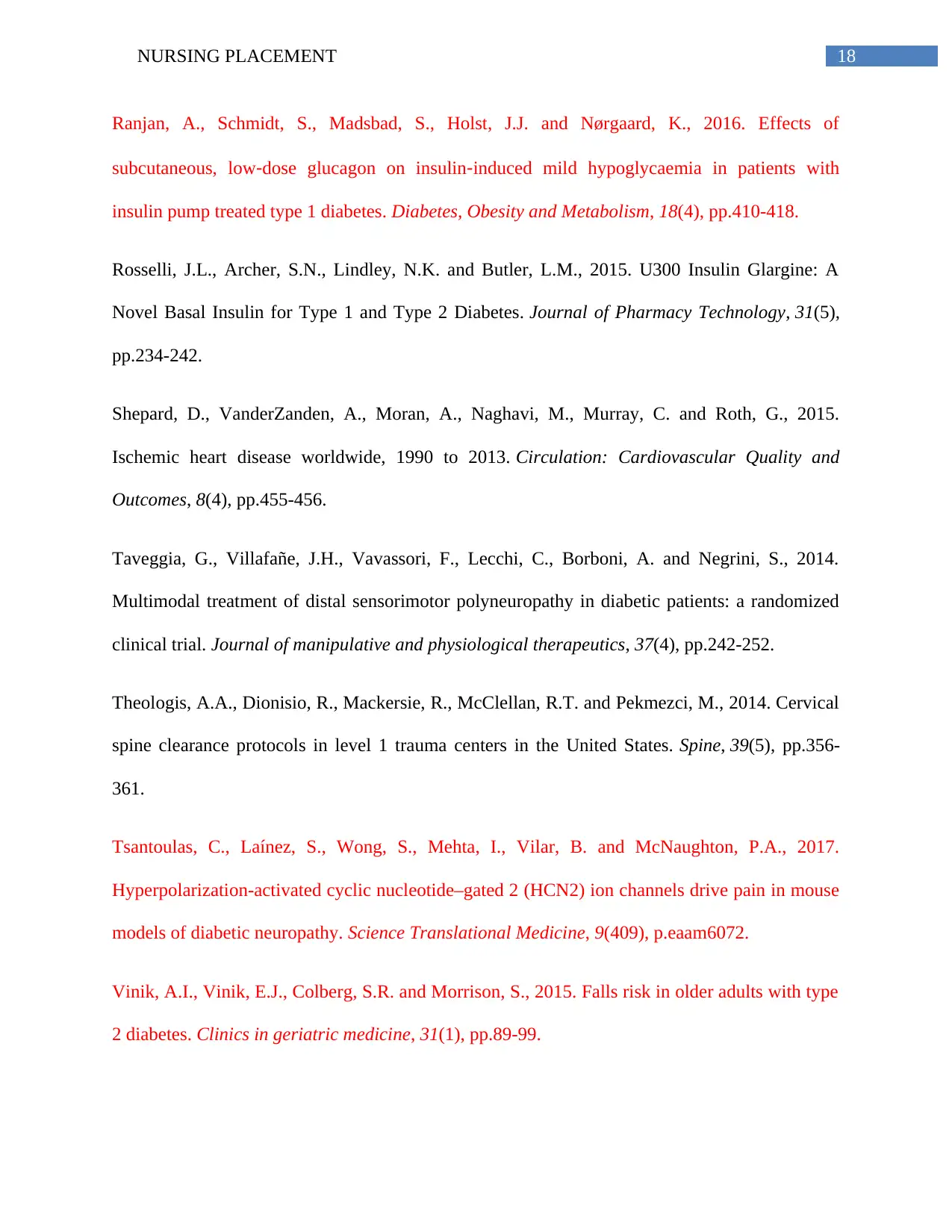
18NURSING PLACEMENT
Ranjan, A., Schmidt, S., Madsbad, S., Holst, J.J. and Nørgaard, K., 2016. Effects of
subcutaneous, low‐dose glucagon on insulin‐induced mild hypoglycaemia in patients with
insulin pump treated type 1 diabetes. Diabetes, Obesity and Metabolism, 18(4), pp.410-418.
Rosselli, J.L., Archer, S.N., Lindley, N.K. and Butler, L.M., 2015. U300 Insulin Glargine: A
Novel Basal Insulin for Type 1 and Type 2 Diabetes. Journal of Pharmacy Technology, 31(5),
pp.234-242.
Shepard, D., VanderZanden, A., Moran, A., Naghavi, M., Murray, C. and Roth, G., 2015.
Ischemic heart disease worldwide, 1990 to 2013. Circulation: Cardiovascular Quality and
Outcomes, 8(4), pp.455-456.
Taveggia, G., Villafañe, J.H., Vavassori, F., Lecchi, C., Borboni, A. and Negrini, S., 2014.
Multimodal treatment of distal sensorimotor polyneuropathy in diabetic patients: a randomized
clinical trial. Journal of manipulative and physiological therapeutics, 37(4), pp.242-252.
Theologis, A.A., Dionisio, R., Mackersie, R., McClellan, R.T. and Pekmezci, M., 2014. Cervical
spine clearance protocols in level 1 trauma centers in the United States. Spine, 39(5), pp.356-
361.
Tsantoulas, C., Laínez, S., Wong, S., Mehta, I., Vilar, B. and McNaughton, P.A., 2017.
Hyperpolarization-activated cyclic nucleotide–gated 2 (HCN2) ion channels drive pain in mouse
models of diabetic neuropathy. Science Translational Medicine, 9(409), p.eaam6072.
Vinik, A.I., Vinik, E.J., Colberg, S.R. and Morrison, S., 2015. Falls risk in older adults with type
2 diabetes. Clinics in geriatric medicine, 31(1), pp.89-99.
Ranjan, A., Schmidt, S., Madsbad, S., Holst, J.J. and Nørgaard, K., 2016. Effects of
subcutaneous, low‐dose glucagon on insulin‐induced mild hypoglycaemia in patients with
insulin pump treated type 1 diabetes. Diabetes, Obesity and Metabolism, 18(4), pp.410-418.
Rosselli, J.L., Archer, S.N., Lindley, N.K. and Butler, L.M., 2015. U300 Insulin Glargine: A
Novel Basal Insulin for Type 1 and Type 2 Diabetes. Journal of Pharmacy Technology, 31(5),
pp.234-242.
Shepard, D., VanderZanden, A., Moran, A., Naghavi, M., Murray, C. and Roth, G., 2015.
Ischemic heart disease worldwide, 1990 to 2013. Circulation: Cardiovascular Quality and
Outcomes, 8(4), pp.455-456.
Taveggia, G., Villafañe, J.H., Vavassori, F., Lecchi, C., Borboni, A. and Negrini, S., 2014.
Multimodal treatment of distal sensorimotor polyneuropathy in diabetic patients: a randomized
clinical trial. Journal of manipulative and physiological therapeutics, 37(4), pp.242-252.
Theologis, A.A., Dionisio, R., Mackersie, R., McClellan, R.T. and Pekmezci, M., 2014. Cervical
spine clearance protocols in level 1 trauma centers in the United States. Spine, 39(5), pp.356-
361.
Tsantoulas, C., Laínez, S., Wong, S., Mehta, I., Vilar, B. and McNaughton, P.A., 2017.
Hyperpolarization-activated cyclic nucleotide–gated 2 (HCN2) ion channels drive pain in mouse
models of diabetic neuropathy. Science Translational Medicine, 9(409), p.eaam6072.
Vinik, A.I., Vinik, E.J., Colberg, S.R. and Morrison, S., 2015. Falls risk in older adults with type
2 diabetes. Clinics in geriatric medicine, 31(1), pp.89-99.
Paraphrase This Document
Need a fresh take? Get an instant paraphrase of this document with our AI Paraphraser

19NURSING PLACEMENT
Wendt, S.L., Ranjan, A., Møller, J.K., Schmidt, S., Knudsen, C.B., Holst, J.J., Madsbad, S.,
Madsen, H., Nørgaard, K. and Jørgensen, J.B., 2017. Cross-validation of a glucose-insulin-
glucagon pharmacodynamics model for simulation using data from patients with type 1
diabetes. Journal of Diabetes Science and Technology, p.1932296817693254.
Wendt, S.L., Ranjan, A., Møller, J.K., Schmidt, S., Knudsen, C.B., Holst, J.J., Madsbad, S.,
Madsen, H., Nørgaard, K. and Jørgensen, J.B., 2017. Cross-validation of a glucose-insulin-
glucagon pharmacodynamics model for simulation using data from patients with type 1
diabetes. Journal of Diabetes Science and Technology, p.1932296817693254.
1 out of 20
Your All-in-One AI-Powered Toolkit for Academic Success.
+13062052269
info@desklib.com
Available 24*7 on WhatsApp / Email
![[object Object]](/_next/static/media/star-bottom.7253800d.svg)
Unlock your academic potential
© 2024 | Zucol Services PVT LTD | All rights reserved.